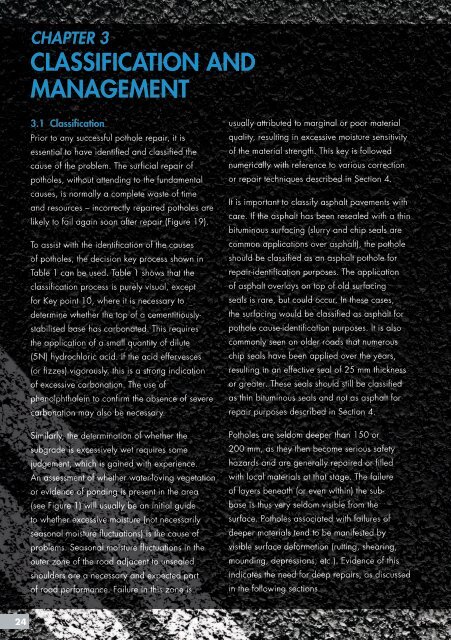POTHOLES: - CSIR
POTHOLES: - CSIR
POTHOLES: - CSIR
- No tags were found...
Create successful ePaper yourself
Turn your PDF publications into a flip-book with our unique Google optimized e-Paper software.
CHAPTER 3CLASSIFICATION ANDMANAGEMENT3.1 ClassificationPrior to any successful pothole repair, it isessential to have identified and classified thecause of the problem. The surficial repair ofpotholes, without attending to the fundamentalcauses, is normally a complete waste of timeand resources – incorrectly repaired potholes arelikely to fail again soon after repair (Figure 19).To assist with the identification of the causesof potholes, the decision key process shown inTable 1 can be used. Table 1 shows that theclassification process is purely visual, exceptfor Key point 10, where it is necessary todetermine whether the top of a cementitiouslystabilisedbase has carbonated. This requiresthe application of a small quantity of dilute(5N) hydrochloric acid. If the acid effervesces(or fizzes) vigorously, this is a strong indicationof excessive carbonation. The use ofphenolphthalein to confirm the absence of severecarbonation may also be necessary.Similarly, the determination of whether thesubgrade is excessively wet requires somejudgement, which is gained with experience.An assessment of whether water-loving vegetationor evidence of ponding is present in the area(see Figure 1) will usually be an initial guideto whether excessive moisture (not necessarilyseasonal moisture fluctuations) is the cause ofproblems. Seasonal moisture fluctuations in theouter zone of the road adjacent to unsealedshoulders are a necessary and expected partof road performance. Failure in this zone isusually attributed to marginal or poor materialquality, resulting in excessive moisture sensitivityof the material strength. This key is followednumerically with reference to various correctionor repair techniques described in Section 4.It is important to classify asphalt pavements withcare. If the asphalt has been resealed with a thinbituminous surfacing (slurry and chip seals arecommon applications over asphalt), the potholeshould be classified as an asphalt pothole forrepair-identification purposes. The applicationof asphalt overlays on top of old surfacingseals is rare, but could occur. In these cases,the surfacing would be classified as asphalt forpothole cause-identification purposes. It is alsocommonly seen on older roads that numerouschip seals have been applied over the years,resulting in an effective seal of 25 mm thicknessor greater. These seals should still be classifiedas thin bituminous seals and not as asphalt forrepair purposes described in Section 4.Potholes are seldom deeper than 150 or200 mm, as they then become serious safetyhazards and are generally repaired or filledwith local materials at that stage. The failureof layers beneath (or even within) the subbaseis thus very seldom visible from thesurface. Potholes associated with failures ofdeeper materials tend to be manifested byvisible surface deformation (rutting, shearing,mounding, depressions, etc.). Evidence of thisindicates the need for deep repairs, as discussedin the following sections.24

















